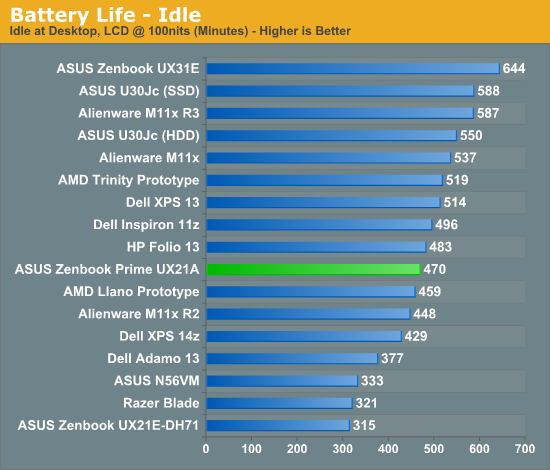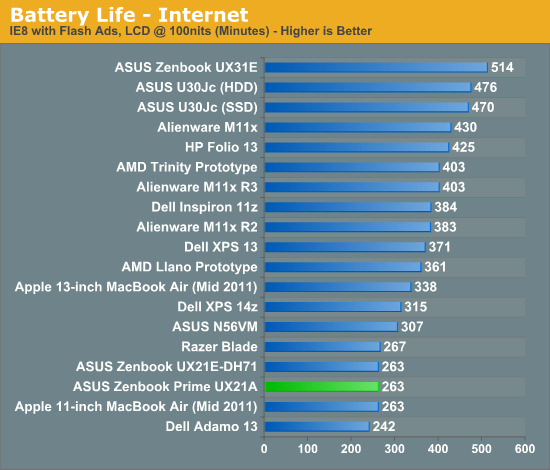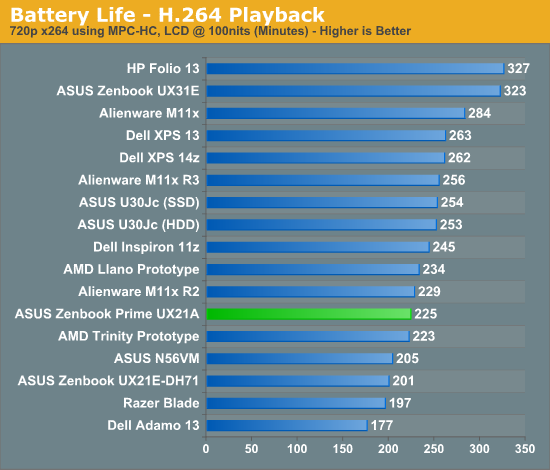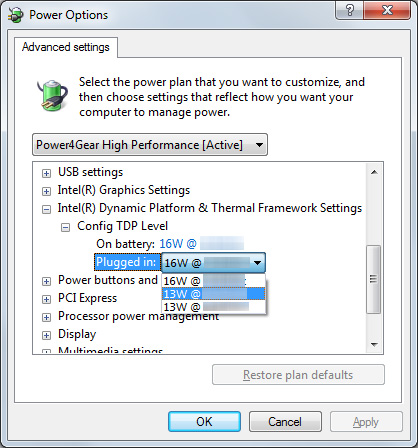ASUS Zenbook Prime (UX21A) Review: The First of the 2nd Gen Ultrabooks
by Anand Lal Shimpi on May 22, 2012 2:46 PM EST- Posted in
- Laptops
- CPUs
- Asus
- Ivy Bridge
- Zenbook
- Zenbook Prime
- Ultrabook
- Notebooks
Battery Life
Generally speaking, the 11-inch Zenbook Prime delivers about the same amount of battery life as its predecessor. For some reason we're able to hit much longer idle battery life on the Prime than the original Zenbook although I'm still trying to find out why. There's also an 11% improvement in our x264 playback test, but on average I'd expect to see similar battery life to the Sandy Bridge model - just with better performance. Note that these results also come despite the fact that ASUS is driving a much higher resolution, and presumably higher power, display than the original Zenbook.



The Zenbook Prime bucks the trend Jarred saw with the first Ivy Bridge notebook review where battery life took a small step backwards. These results bode well for future Ivy Bridge notebooks and Ultrabooks. It still remains to be seen if Intel's 22nm process will actually give us a battery life advantage in any notebook compared to its predecessor. It's possible that we are seeing some of the benefits of 22nm here already and they are simply offset by the more power hungry display. With the move to 22nm Intel should have a better hold on active power and leakage, but it's always possible that we'll have to wait until Haswell for the process to really be exploited.
Just like last time, ASUS has a couple of widgets to quickly change between power settings. The instant on widget lets you switch between suspend to RAM and suspend to disk modes. The former is expected to deliver up to 2 weeks of standby battery life, while the latter can push up to 150 days. I didn't have the time to test these claims (life is short, I draw the line at spending it testing claims of 150 day standby battery life). ASUS once again includes a counter that estimates how long your system will last in either mode based on current charge levels and power usage.
The next widget is a quick tool to let you switch between high performance and battery saver Power4Gear power profiles. You can customize these profiles via the Windows control panel, but it's nice to have a button on the desktop that lets you quickly switch between them.
Configurable TDP
One feature of Ivy Bridge that we haven't been able to test until now is configurable TDP. While most Ultrabook CPUs ship with a 17W TDP, that's mostly an arbitrary thermal/power rating. If an OEM wants to design a chassis that can only accept a 13W part it previously had to hope that Intel would make such a thing. Alternatively, the OEM could underclock/undervolt a 17W chip on their own and hope to mimic Intel's validation and deliver a 13W configuration of their own. The former requires that a significant number of OEMs demand the part, while the latter is just too risky for the larger OEMs (get too aggressive on the undervolting side and end up with a bunch of unstable systems). The solution Intel proposed with Ivy Bridge is configurable TDP. For Ultrabooks this means you can set a 17W part to 13W.

Currently the setting is hidden away in Windows 7's power management settings. Once again I've had to censor the clock speeds here due to Intel's Ultrabook embargo:
You can map the 13W settings to the battery saver profile and then, at the click of a button, have a 13W Zenbook Prime instead of a 17W model. The difference in performance isn't significant however:
| ASUS Zenbook Prime Configurable TDP Performance - Cinebench 11.5 (Multithreaded) | |||||||
| 16W - Max Freq | 13W - Mid Freq | 13W - Lowest Freq | |||||
| ASUS Zenbook Prime UX21A | 2.79 | 2.67 | 2.67 | ||||
I'm still running battery life tests to quantify the impact on power consumption, but it's conceptually a neat thing to see in action finally. I suspect configurable TDP is going to play a major role with Haswell and convertible/dockable Ultrabook-tablet hybrids.
Thermals and Noise
As with most high performance notebooks that are this thin, cooling is difficult. Under load the fans in the Zenbook Prime are definitely audible, but in general ASUS does a better job cooling everything inside the Zenbook Prime than Apple does in the MacBook Air. I suspect much of this boils down to how aggressive Apple is about keeping fan speed/noise down compared to ASUS' desire to maintain a certain temperature level inside the chassis.










192 Comments
View All Comments
Paedric - Tuesday, May 22, 2012 - link
I don't know for virtual machines, but games are already barely playable even with reduced resolution.This is not a gaming system or workstation you know, this is web surf/ Facebook/other lightweight applications system; adding more RAM is basically useless and will only reduce battery life.
Judging by your comment, this is not the form factor you need, we're not there yet for gaming performance in a 11" ultrabook.
nortexoid - Tuesday, May 22, 2012 - link
Actually more RAM will in most cases improve battery life and performance since it can greatly reduce disk swapping. Fortunately the Zenbook has an SSD so performance won't suffer much from swapping, but if you have just a few apps open ( browser, Word, music player, etc.) that 4GB will go FAST.Manufacturers really need to start moving to 6GB default or else 2/4GB onboard plus a vacant DIMM slot.
puppies - Wednesday, May 23, 2012 - link
Rubbish rubbish rubbish. I have 4gb on my XPS 17, i've had 1GB dedicated to a minecraft server, had music playing, multiple office documents open, and multiple browser pages up and never even got close to maxing my RAM.I can only presume you don't understand how windows grabs way more RAM than it needs (2GBish) and releases it if another program requires it otherwise you are talking about having 20 doccuments and 20 web pages open while attempting to play a resource intensive game at the same time which would turn that low power enveloped CPU into a stuttering mess way before it touched the last 25% of the RAM.
Spathi - Wednesday, May 23, 2012 - link
He speaks the truth nortexoid,I have 16g in my desktop and it uses 12G and I imagine windows would use 6g of 8g and 3g of 4g. Mostly useless caching.
Memory actually uses lots of power (relative to the notebooks current use), so you don't really want to add more.
IMHO, this nb is designed as a gift/recommendation to your gf/wife/mother/aunty/dad. It is the sort of thing you can get them and steal on the holidays when bored, but won't be tempted to steal every day.
It would probably play enough fun games OK, just not the latest at high res. So also good for work/uni without getting carried away gaming. Most of the "latest" candy games are boring anyway after an hour, lol.
ImSpartacus - Wednesday, May 23, 2012 - link
That's not always true. I'm rolling with 8GB of RAM in my Win7 laptop and I've never seen the system use more than half of it. I'm usually around 2GB with Chrome (5-15 tabs), Word and PowerPoint open.Admittedly, my use case is light. However, that is "just a few apps open," yet 4GB has not gone "FAST".
Lucian Armasu - Tuesday, May 22, 2012 - link
Do you really think you're going to need more than 4GB of RAM with the type of GPU's ultrabooks are having?nortexoid - Tuesday, May 22, 2012 - link
Yes, if you don't want to quit all your open apps just to play a game.Sunburn74 - Tuesday, May 22, 2012 - link
Gaming isn't a major feature of this laptop. Its more of a happenstance.The power hit from the extra ram affects use when not gaming. The extra ram is only really useful for a few specific situations (situations which the laptop is not particularly designed for anyway).
seapeople - Saturday, May 26, 2012 - link
You realize that Windows has something called the Page File, right? And that this computer (and most ultrabooks) have a solid state drive?bhima - Wednesday, May 23, 2012 - link
For Graphic Designers on the go, this could be a pretty great machine with that nice monitor but 4GB of ram IS limiting when you are working with 3 adobe programs open and large, 300dpi files.